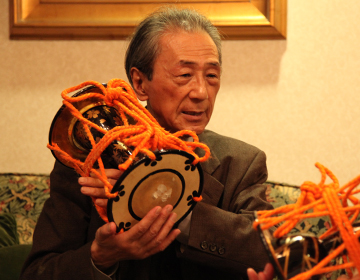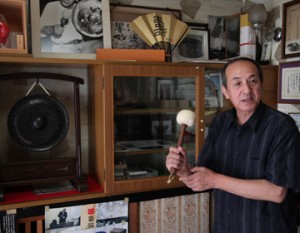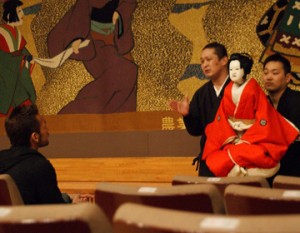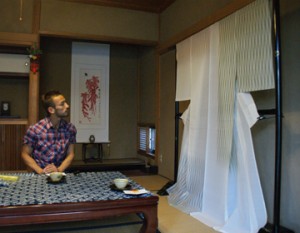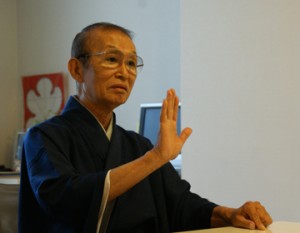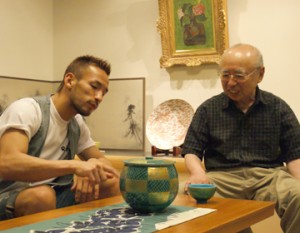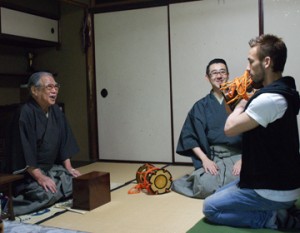Standing on stage for Kabuki, Nagauta, Noh
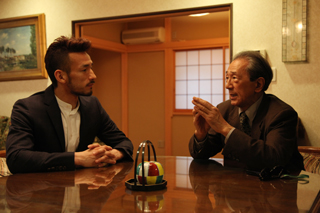
We visited Kisaku Katada, Hayashikata for Kabuki Nagauta, accredited holder of Important Intangible Cultural Property. Katada is the second son of Mochizuki Tazaemon the 9th of Kabuki Nagauta Hayashi Mochizuki-ryu. He was immersed in Nagauta Hayashi since he was very young, and at age 16, he studied under Katada Kisouji, his uncle. Two years later he was given the name Katada Kisaku the 3rd. His older brother succeeded Mochizuki-ryu while he succeeded Katada-ryu. Katada participates in different types of performances, performing as hayashikata for Kabuki, and at times performing Nagauta for Noh performances.
The difference between Japanese music and western music
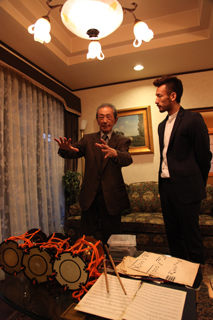
Katada has always been a fan of jazz. ”I’ve never bought tickets to a hayashi performance, but I buy tickets to listen to jazz.” he chuckles. Since he was 18, he has participated in recording ohayashi fusion with Western music.
”I wasn’t scared to jump into the world of Western music. I was able to learn a lot. Western music uses rhythm of the metronome. In Japanese music, instruments such as the tsuzumi does not use notes ”doh” ”rei” ”mi”, and the shamisen and okoto have a unique ”billowing” which the percussion instruments have to capture. Western music and Japanese music have different ”objectives”. That was the tough part, yet also extremely interesting.”
Music scores that are passed on

We were told it was best to listen to the music first, and a notebook was taken out. Inside the notebook were a lot of circles and crosses. ”This is our musical score,” Katada laughed.
”Someone held onto the score book even during times of war. Back then, there wasn’t any printing technology, so losing it would mean it was lost forever. When he was taken hostage, the notebook was taken away because they suspected it contained some kind of secret code.” .
As Katada explained, Japanese musical scores are an important asset for the musician. The complex hayashikata dialogue is outlined in the notebook. It cannot be deciphered by amateurs, so instead, we listened to the actual performance.
The performer’s touch
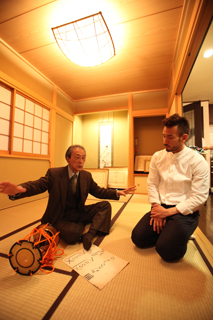
Looking at the score, Katada hits the tsuzumi, explaining as he plays – this means ”ta”, this is ”pon”. As soon as we heard the tsuzumi, it was as if the entire performance was unfolding in front of us. We also observed the dialogue between the kozutsumi and ohzutsumi. The two types of tsuzumi set off a comfortable beat that vibrated within our bodies, making Nakata comment, ”Maybe it’s because I heard your story about, but it felt like there was a jazzy rhythm.”
”Yes. Maybe that’s true. Tsuzumi scores are not written to match the shamisen, yet it matches perfectly. That is made possible by the performer’s touch. If it doesn’t seem to match, they hit it in pianissimo (softly), if it matches, they hit it in fortissimo (strongly). This is all done with the performer’s touch.” With jazz improvisation, you need to express yourself while performing with the other musicians. ”With music, the instruments are the same, but the style of music is not the same. You could say that ohayashi music has a variety of expressions,” says Katada, who has been playing a vital role in the world of Japanese traditional music. He supports the diversity of performances with his touch.



